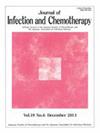基质辅助激光解吸附/电离飞行时间质谱法直接鉴定血培养阳性标本中的细菌对医生选择抗菌疗法的影响。
IF 1.9
4区 医学
Q3 INFECTIOUS DISEASES
引用次数: 0
摘要
背景:快速鉴定血流感染中的致病菌对于及早启动适当的抗菌治疗至关重要。使用基质辅助激光解吸/电离飞行时间质谱法直接鉴定阳性血培养瓶中的细菌是一种很有前景的应用。目前已报道了多种直接鉴定方法,但很少有研究评估这些方法对医生抗菌治疗决策的影响:方法:我们开发了一种简单的细菌直接鉴定方法,并将其应用于日常临床实践,研究直接鉴定血培养阳性瓶中细菌对医生选择抗菌药物治疗的影响:从2016年1月至2022年12月,我们尝试对98个病例进行直接鉴定,并成功获得88个病例的鉴定结果。在 3 个病例中,静脉穿刺进行血培养时未使用经验性抗菌药物,但后来根据直接鉴定结果使用了抗菌药物。在其余 85 例病例中,经验性抗菌药物治疗是在进行血液培养时启动的,29 例病例的经验性抗菌药物治疗是在直接鉴定后更改的。在这 29 个病例中,有 17 个病例的抗菌治疗是根据细菌属/种的直接鉴定结果而改变的,结果在抗菌药物敏感性检测结果出来之前,就已经改用了有效的抗菌治疗:结论:从阳性血培养瓶中直接鉴定细菌有助于主治医生更早地选择或改变抗菌疗法。本文章由计算机程序翻译,如有差异,请以英文原文为准。
Impact of direct identification of bacteria in blood culture–positive specimens by matrix-assisted laser desorption/ionization–time-of-flight mass spectrometry on physician selection of antimicrobial therapy
Background
Rapid identification of the causative organism in blood stream infections is essential for early initiation of appropriate antimicrobial therapy. Direct identification of bacteria in positive blood culture bottles using matrix-assisted laser desorption/ionization–time-of-flight mass spectrometry is a promising application. A variety of direct identification methods have been reported; however, few studies have evaluated the impact of these methods on physician decision making regarding antimicrobial therapy.
Methods
We developed a simple method for direct bacterial identification and applied it to daily clinical practice to investigate the impact of direct identification of bacteria in positive blood culture bottles on physicians’ choice of antimicrobial agents for treatment.
Results
From January 2016 to December 2022, we attempted direct identification in 98 cases and successfully acquired identification results in 88 cases. In three cases, no empiric antimicrobial agents were initiated at the time of venipuncture for blood culture but later initiated based on the direct identification results. In the remaining 85 cases, empiric antimicrobial therapy was initiated at the time blood cultures were performed, and in 29 cases, empiric antimicrobial therapy was changed after direct identification. In 17 of these 29 cases, the antimicrobial therapy was changed based on the direct identification of bacterial genus/species, resulting in a change to an effective antimicrobial therapy before the antimicrobial susceptibility testing results were available.
Conclusions
Direct identification of bacteria from positive blood culture bottles could contribute to earlier selection of or changes to antimicrobial therapies by attending physicians.
求助全文
通过发布文献求助,成功后即可免费获取论文全文。
去求助
来源期刊

Journal of Infection and Chemotherapy
INFECTIOUS DISEASES-PHARMACOLOGY & PHARMACY
CiteScore
4.10
自引率
4.50%
发文量
303
审稿时长
47 days
期刊介绍:
The Journal of Infection and Chemotherapy (JIC) — official journal of the Japanese Society of Chemotherapy and The Japanese Association for Infectious Diseases — welcomes original papers, laboratory or clinical, as well as case reports, notes, committee reports, surveillance and guidelines from all parts of the world on all aspects of chemotherapy, covering the pathogenesis, diagnosis, treatment, and control of infection, including treatment with anticancer drugs. Experimental studies on animal models and pharmacokinetics, and reports on epidemiology and clinical trials are particularly welcome.
 求助内容:
求助内容: 应助结果提醒方式:
应助结果提醒方式:


